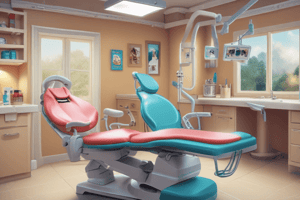Podcast
Questions and Answers
What is clear aligner therapy used for?
What is clear aligner therapy used for?
- To whiten teeth
- To treat tooth decay
- To straighten teeth (correct)
- To perform oral surgery
What is a key aesthetic advantage of clear aligners?
What is a key aesthetic advantage of clear aligners?
- They are colorful
- They are bulky
- They are shiny
- They are virtually invisible (correct)
What is a comfort advantage of clear aligners?
What is a comfort advantage of clear aligners?
- They are heavy
- They are made of sharp metal
- They are thick and rigid
- They are made of smooth, flexible plastic (correct)
When can patients remove their clear aligners?
When can patients remove their clear aligners?
How are clear aligners fabricated?
How are clear aligners fabricated?
How often do patients typically switch to a new aligner?
How often do patients typically switch to a new aligner?
Flashcards are hidden until you start studying
Study Notes
Overview of Clear Aligner Therapy
- Clear aligner therapy is a type of orthodontic treatment that uses a series of clear, removable, and custom-made aligners to straighten teeth.
- It is an alternative to traditional metal braces and is often preferred for its aesthetic appeal and convenience.
Advantages of Clear Aligner Therapy
- Aesthetics: Clear aligners are virtually invisible, making them a popular choice for patients who want to maintain a professional or social appearance during treatment.
- Comfort: Clear aligners are made of smooth, flexible plastic that is gentle on the teeth and gums.
- Convenience: Aligners can be removed for eating, drinking, and oral hygiene, making it easier to maintain good oral health during treatment.
- Flexibility: Patients can remove aligners for special occasions or events.
How Clear Aligner Therapy Works
- Initial Consultation: The orthodontist or dentist takes impressions of the patient's teeth and creates a digital model.
- Treatment Planning: The orthodontist or dentist creates a customized treatment plan, including the number of aligners and the duration of treatment.
- Aligner Fabrication: The aligners are fabricated using 3D printing technology.
- Wearing Aligners: The patient wears each aligner for a specified period (usually 1-2 weeks) before switching to the next one.
- Regular Check-ups: The patient attends regular check-ups with the orthodontist or dentist to monitor progress and receive new aligners.
Indications and Contraindications
- Indications: Mild to moderate crowding, spacing, or orthodontic relapse cases.
- Contraindications: Complex cases requiring significant tooth movement, severe crowding, or cases requiring extractions.
Clear Aligner Therapy vs. Traditional Braces
- Clear Aligners: Removable, aesthetic, and convenient, but may not be suitable for complex cases.
- Traditional Braces: Fixed, effective for complex cases, but may be less aesthetically pleasing and more uncomfortable.
Common Clear Aligner Brands
- Invisalign
- ClearCorrect
- SmileDirectClub
- others
What is Clear Aligner Therapy?
- Clear aligner therapy is a type of orthodontic treatment that uses a series of clear, removable, and custom-made aligners to straighten teeth.
- It is an alternative to traditional metal braces and is often preferred for its aesthetic appeal and convenience.
Advantages of Clear Aligner Therapy
- Aesthetics: Clear aligners are virtually invisible, making them a popular choice for patients who want to maintain a professional or social appearance during treatment.
- Comfort: Clear aligners are made of smooth, flexible plastic that is gentle on the teeth and gums.
- Convenience: Aligners can be removed for eating, drinking, and oral hygiene, making it easier to maintain good oral health during treatment.
- Flexibility: Patients can remove aligners for special occasions or events.
How Clear Aligner Therapy Works
- Initial Consultation: The orthodontist or dentist takes impressions of the patient's teeth and creates a digital model.
- Treatment Planning: The orthodontist or dentist creates a customized treatment plan, including the number of aligners and the duration of treatment.
- Aligner Fabrication: The aligners are fabricated using 3D printing technology.
- Wearing Aligners: The patient wears each aligner for a specified period (usually 1-2 weeks) before switching to the next one.
- Regular Check-ups: The patient attends regular check-ups with the orthodontist or dentist to monitor progress and receive new aligners.
Indications and Contraindications
- Indications: Mild to moderate crowding, spacing, or orthodontic relapse cases.
- Contraindications: Complex cases requiring significant tooth movement, severe crowding, or cases requiring extractions.
Clear Aligner Therapy vs. Traditional Braces
- Clear Aligners: Removable, aesthetic, and convenient, but may not be suitable for complex cases.
- Traditional Braces: Fixed, effective for complex cases, but may be less aesthetically pleasing and more uncomfortable.
Common Clear Aligner Brands
- Invisalign
- ClearCorrect
- SmileDirectClub
- others
Studying That Suits You
Use AI to generate personalized quizzes and flashcards to suit your learning preferences.



